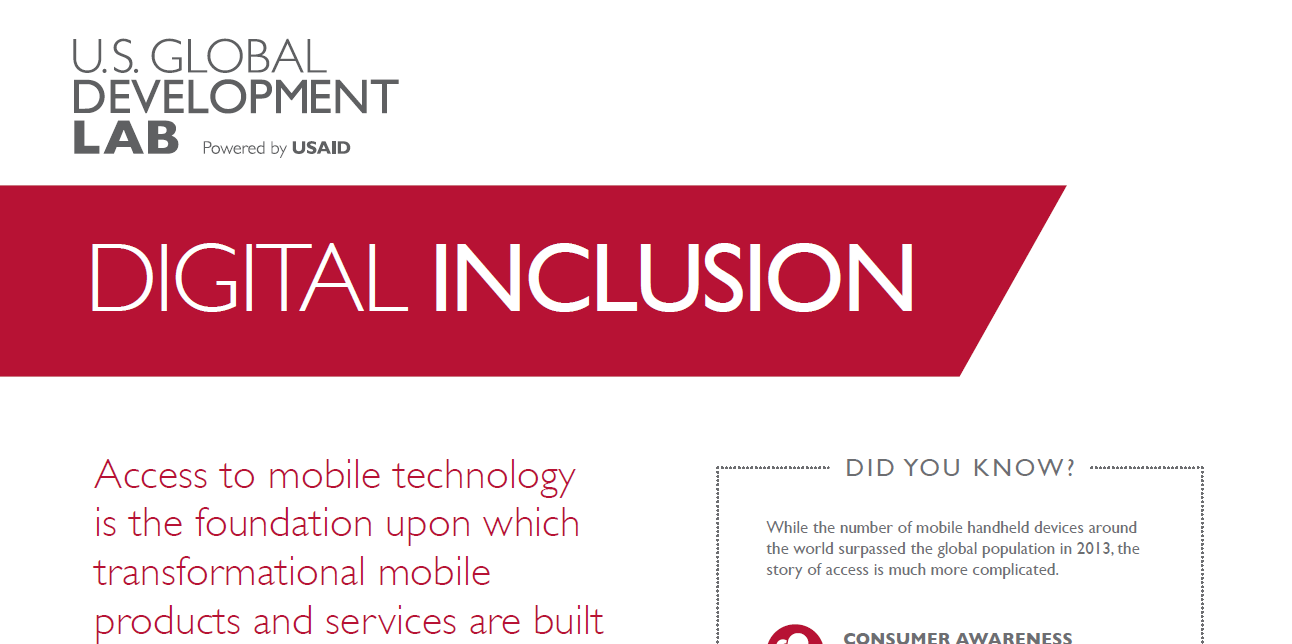Speeches Shim
Digital Inclusion Fact Sheet ![]() (pdf - 1 MB)
(pdf - 1 MB)
Access to mobile technology is the foundation upon which transformational mobile products and services are built.
Digital inclusion means more than an available mobile connection. It also means an individual’s ability to afford the services provided, value them, and have the ability to use them. Only then will mobile applications and platforms, like mobile money and mobile data, reach their full potential. Ensuring universal access is going to take a combined effort of companies, governments, NGOs, and the international development community to create an enabling policy and regulatory environment, build new business models, and cultivate relevant local content.
Did you know?
While the number of mobile handheld devices around the world surpassed the global population in 2013, the story of access is much more complicated.
CONSUMER AWARENESS
Despite the tremendous value of agricultural information, only 5 percent of base of the pyramid users in Kenya are aware of commodity pricing services and applications
AFFORDABILITY
In some African countries, broadband costs are 1,000+ percent of average monthly income
LOCALLY RELEVANT CONTENT
78 percent of all available Internet sites originate in the U.S. or EU
ATTAINABILITY
548 million mobile users do not have access to the power grid
CONNECTIVITY
90+ percent of the people in the world’s 49 least developed countries lack internet access
Closing the Gender Gap
A woman is 21 percent less likely than a man to own a phone in low and middle-income countries. Globally, this equates to a mobile phone gender gap of roughly 300 million women. USAID’s partnership with GSMA, AusAID, and Visa, the GSMA Connected Women Program, aims to enable 150 million underserved women to own and effectively use mobile phones to access vital information, networks, and services.
Reaching Two Million Iraqi Women
In 2011, only 20 percent of Iraqi mobile operator Asiacell’s subscribers were women. Research produced that year through the GSMA mWomen Program sparked Asiacell to design a new product catering to women called the Almas Line, which includes features like rate reductions during off-peak hours and a “bye-bye” option to block potential harassers. In two years, more than two million women have enrolled, doubling the proportion of Asiacell’s female customers.
Bringing Internet Prices Within Reach
Today, in many developing countries, more than half of Internet users access it exclusively through mobile devices. This is set to grow as smartphones and tablets become more available. Access to the Internet drives economic growth, but mobile broadband costs are prohibitively high for most people in developing countries. USAID’s partnership with Google.org, Omidyar Network, DFID, and a host of other governments, technology providers, civil society groups, and academia is empowering policy makers with the tools and resources to facilitate more open, competitive markets. This partnership, the Alliance for Affordable Internet, aims to bring broadband prices down to no more than 5 percent of monthly income, enabling the next two billion users to come online.
About Digital Development
USAID’s Digital Development team fosters transformative and market-driven solutions to empower individuals through financial inclusion, data-driven evidence, and access to mobile technology. We offer knowledge tools and support to dramatically increase the adoption of mobile technology throughout USAID’s programs, and we partner with other donors, governments, companies, and NGOs to accelerate proven solutions that impact millions.
FIND OUT MORE
References


Comment
Make a general inquiry or suggest an improvement.